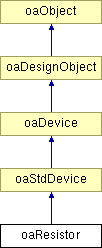 |
 |
 |
||||||
Inheritance diagram for oaResistor:

 |
 |
Public Methods | |
| oaUInt4 | getWidth () const |
| oaUInt4 | getLength () const |
| oaUInt4 | getHeight () const |
| oaUInt4 | getNumCuts () const |
| oaUInt4 | getCutArea () const |
| oaUInt4 | getCutPerimeter () const |
| oaBoolean | hasWidth () const |
| oaBoolean | hasLength () const |
| oaBoolean | hasHeight () const |
| oaBoolean | hasNumCuts () const |
| oaBoolean | hasCutArea () const |
| oaBoolean | hasCutPerimeter () const |
| void | setWidth (oaUInt4 width) |
| void | setLength (oaUInt4 length) |
| void | setHeight (oaUInt4 height) |
| void | setNumCuts (oaUInt4 numCuts) |
| void | setCutArea (oaUInt4 cutArea) |
| void | setCutPerimeter (oaUInt4 cutPerimeter) |
Static Public Methods | |
| oaResistor * | create (oaNode *fromNode, oaNode *toNode) |
| oaResistor * | create (oaNode *fromNode, oaNode *toNode, oaUInt4 id) |
|
||||||||||||||||
|
This function creates a resistor belonging to the parasitic network containing fromNode and toNode. An exception will be thrown if the id is the reserved oacInvalidDeviceID value or if a device with the specified id value already exists. The hasId() function will return true for devices created with this function and the getId() function will return the user-specified id. Resistors can be created between nodes in different partitions of the same root parasitic network, where one of the partitions must be an ancestor of the other. In this case, the resistor will be created in the lower level partition, and the node in the higher level partition must have an id so that it can be found when loading the lower level partition.
|
|
||||||||||||
|
This function creates a resistor belonging to the specified parasitic network. The device created will not have an ID associated with it. The hasId() function will return false for these devices and the getId() function will return an oacInvalidDeviceID value. Resistors can be created between nodes in different partitions of the same root parasitic network, where one of the partitions must be an ancestor of the other. In this case, the resistor will be created in the lower level partition, and the node in the higher level partition must have an id so that it can be found when loading the lower level partition.
|
|
|
This function returns the cut area associated with this resistor. |
|
|
This function returns the cut area perimeter associated with this resistor. |
|
|
This function returns the effective height associated with this resistor. |
|
|
This function returns the effective length associated with this resistor. |
|
|
This function returns the number of cuts associated with this resistor. |
|
|
This function returns the effective width associated with this resistor. |
|
|
This function returns a boolean indicating whether or not this resistor has cut area. |
|
|
This function returns a boolean indicating whether or not this resistor has cut perimeter. |
|
|
This function returns a boolean indicating whether or not this resistor has height. |
|
|
This function returns a boolean indicating whether or not this resistor has length. |
|
|
This function returns a boolean indicating whether or not this resistor has number of cuts. |
|
|
This function returns a boolean indicating whether or not this resistor has width. |
|
|
This function sets the cut area of this resistor to the specified value.
|
|
|
This function sets the cut perimeter of this resistor to the specified value.
|
|
|
This function sets the effective height of this resistor to the specified height.
|
|
|
This function sets the effective length of this resistor to the specified length.
|
|
|
This function sets the number of cuts of this resistor to the specified value.
|
|
|
This function sets the effective width of this resistor to the specified width.
|

Copyright © 2002 - 2010 Cadence Design Systems, Inc.
All Rights Reserved.